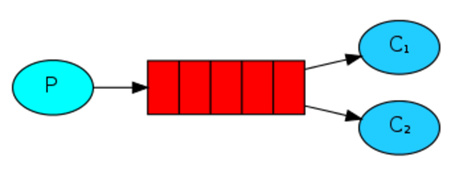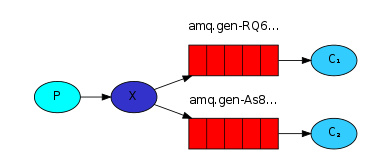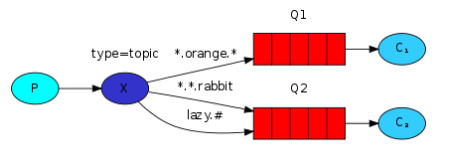RabbitMQ是一个开源的,实现AMQP协议的,可复用企业消息队列系统。
类似的系统还有ActiveMQ(实现JMS)和Kafka(分布式)。RabbitMQ支持主流的操作系统,支持多种开发语言,能降低系统间访问的耦合度,便于数据同步。
RabbitMQ提供如下5种队列模型(远程调用不是消息队列)。
1.Simple

2.Work. 工作模式,一个消息只能被一个消费者获取。

3.Publish/Subscribe. 订阅模式,消息被路由投递给多个队列,一个消息被多个消费者获取。ExchangeType为fanout。

4.Routing. 路由模式,一个消息被多个消费者获取。并且消息的目的queue可被生产者指定。ExchangeType为direct。

5.Topic. 通配符模式,一个消息被多个消费者获取。消息的目的queue可用BindingKey以通配符(#:一个或多个词,*:一个词)的方式指定。ExchangeType为topic。

6.PRC. 远程调用

相关名词:
1. Server:RabbitMQ服务器,
2. VirtualHost:权限控制的基本单位,一个VirtualHost里面有若干Exchange和MessageQueue,以及指定被哪些user使用。
3. Connection:生产者/消费者和RabbitMQ服务器的TCP连接。
4. Channel:创建完Connection后,需创建信道才能执行AMQP命令。一个Connection可以创建多个Channel。
5. Exchange:路由。接受生产者发送的消息,并根据Binding规则将消息路由给服务器中的队列。ExchangeType有fanout、direct和topic三种,对应路由使用上述3/4/5号模型。
6. (Message)Queue:消息队列,用于存储还未被消费者消费的消息。
7. Message:由Header和Body组成。Header是生产者添加的相关属性:是否持久化、被哪个MessageQueue接收、优先级等。而Body是传输的数据。
8. Binding:消息被复制传递时,一个消费者对应一个消息队列,消费者绑定MessageQueue到Exchange,可指定多个Bindingkey。生产者在发送Message时,可以在header指定RoutingKey,Exchange匹配RoutingKey和Bindingkey将Message路由到相应的Queue。
9. Command:AMQP命令,生产者/消费者通过Command完成与RabbitMQ服务器交互。Publish:发送消息,txSelect:开启事务,txCommit:提交事务。
程序员应该用代码来表达自己的思想,下面用代码展示以上五种模式:
首先创建工厂类,获取Connection
public class ConnectionUtil { public static Connection getConnection() throws Exception { //connection工厂 ConnectionFactory factory = new ConnectionFactory(); factory.setHost("localhost"); factory.setPort(5672); factory.setUsername("zx"); factory.setPassword("zx"); factory.setVirtualHost("/zx"); // 通过工厂获取连接 Connection connection = factory.newConnection(); return connection; } }
1.Simple
生产者
public class Send { private final static String QUEUE_NAME = "queue_simple"; public static void main(String[] argv) throws Exception { // 获取连接 Connection connection = ConnectionUtil.getConnection(); // 创建通道 Channel channel = connection.createChannel(); // 声明队列 (不存在则创建) channel.queueDeclare(QUEUE_NAME, false, false, false, null); // 发送消息 String message = "Hello World"; channel.basicPublish("", QUEUE_NAME, null, message.getBytes()); // 关闭通道和连接 channel.close(); connection.close(); } }
消费者
public class Recv { private final static String QUEUE_NAME = "queue_simple"; public static void main(String[] argv) throws Exception { // 获取连接 Connection connection = ConnectionUtil.getConnection(); // 创建通道 Channel channel = connection.createChannel(); // 声明队列 channel.queueDeclare(QUEUE_NAME, false, false, false, null); // 定义队列的消费者 QueueingConsumer consumer = new QueueingConsumer(channel); // 监听队列 channel.basicConsume(QUEUE_NAME, true, consumer); //true 自动确认消息, 下有详解 // 获取消息 while (true) { QueueingConsumer.Delivery delivery = consumer.nextDelivery(); //阻塞或轮询 String message = new String(delivery.getBody()); System.out.println("获取:" + message); } } }
2.Work
生产者
public class Send { private final static String QUEUE_NAME = "queue_work"; public static void main(String[] argv) throws Exception { Connection connection = ConnectionUtil.getConnection(); Channel channel = connection.createChannel(); // 声明队列 channel.queueDeclare(QUEUE_NAME, false, false, false, null); for (int i = 0; i < 50; i++) { String message = "" + i; channel.basicPublish("", QUEUE_NAME, null, message.getBytes()); Thread.sleep(i * 10); } channel.close(); connection.close(); } }
消费者1
public class Recv1 { private final static String QUEUE_NAME = "queue_work"; public static void main(String[] argv) throws Exception { Connection connection = ConnectionUtil.getConnection(); Channel channel = connection.createChannel(); channel.queueDeclare(QUEUE_NAME, false, false, false, null); // 开启Qos, 同一时刻服务器只发送一条消息. 可以尝试注释该行, 会发现消息会被平均分配给两个消费者 channel.basicQos(1); QueueingConsumer consumer = new QueueingConsumer(channel); channel.basicConsume(QUEUE_NAME, false, consumer); while (true) { QueueingConsumer.Delivery delivery = consumer.nextDelivery(); String message = new String(delivery.getBody()); System.out.println("获取:" + message); // 模拟handling Thread.sleep(100); // 手动确认消息接收. 在basicConsume方法中, true为自动, false为手动 /* 消息确认方式: * 1. 自动确认. 只要消息从队列中移除, 服务端认为消息被成功消费 * 2. 手动确认. 消费者获取消息后, 服务器将该消息标记为不可用, 并等待反馈. 如果消费者一直不反馈, 则该消息将一直处于不可用状态 */ channel.basicAck(delivery.getEnvelope().getDeliveryTag(), false); } } }
消费者2
public class Recv2 { private final static String QUEUE_NAME = "queue_work"; public static void main(String[] argv) throws Exception { Connection connection = ConnectionUtil.getConnection(); Channel channel = connection.createChannel(); channel.queueDeclare(QUEUE_NAME, false, false, false, null); channel.basicQos(1); QueueingConsumer consumer = new QueueingConsumer(channel); channel.basicConsume(QUEUE_NAME, false, consumer); while (true) { QueueingConsumer.Delivery delivery = consumer.nextDelivery(); String message = new String(delivery.getBody()); System.out.println(" [x] Received '" + message + "'"); // 模拟handling Thread.sleep(200); // ACK channel.basicAck(delivery.getEnvelope().getDeliveryTag(), false); } } }
3.Publish/Subscribe
生产者
public class Send { private final static String EXCHANGE_NAME = "exchange_fanout"; public static void main(String[] argv) throws Exception { Connection connection = ConnectionUtil.getConnection(); Channel channel = connection.createChannel(); // 声明exchange channel.exchangeDeclare(EXCHANGE_NAME, "fanout"); // 消息内容 String message = "Hello world"; // 与前面不同, 生产者将消息发送给exchange, 而非队列. 若发消息时还没消费者绑定queue与该exchange, 消息将丢失 channel.basicPublish(EXCHANGE_NAME, "", null, message.getBytes()); channel.close(); connection.close(); } }
消费者1
public class Recv1 { private final static String QUEUE_NAME = "queue_fanout_1"; private final static String EXCHANGE_NAME = "exchange_fanout"; public static void main(String[] argv) throws Exception { Connection connection = ConnectionUtil.getConnection(); Channel channel = connection.createChannel(); channel.queueDeclare(QUEUE_NAME, false, false, false, null); // 绑定队列到交换机. 绑定也可在rabbitMQ的管理界面进行 channel.queueBind(QUEUE_NAME, EXCHANGE_NAME, ""); channel.basicQos(1); QueueingConsumer consumer = new QueueingConsumer(channel); channel.basicConsume(QUEUE_NAME, false, consumer); while (true) { QueueingConsumer.Delivery delivery = consumer.nextDelivery(); String message = new String(delivery.getBody()); System.out.println("获取:" + message); Thread.sleep(100); channel.basicAck(delivery.getEnvelope().getDeliveryTag(), false); } } }
消费者2
public class Recv2 { private final static String QUEUE_NAME = "queue_fanout_2"; private final static String EXCHANGE_NAME = "exchange_fanout"; public static void main(String[] argv) throws Exception { Connection connection = ConnectionUtil.getConnection(); Channel channel = connection.createChannel(); channel.queueDeclare(QUEUE_NAME, false, false, false, null); // 绑定队列到交换机 channel.queueBind(QUEUE_NAME, EXCHANGE_NAME, ""); channel.basicQos(1); QueueingConsumer consumer = new QueueingConsumer(channel); channel.basicConsume(QUEUE_NAME, false, consumer); while (true) { QueueingConsumer.Delivery delivery = consumer.nextDelivery(); String message = new String(delivery.getBody()); System.out.println("获取:" + message); Thread.sleep(200); channel.basicAck(delivery.getEnvelope().getDeliveryTag(), false); } } }
4.Routing
生产者
public class Send { private final static String EXCHANGE_NAME = "exchange_direct"; public static void main(String[] argv) throws Exception { Connection connection = ConnectionUtil.getConnection(); Channel channel = connection.createChannel(); // 声明exchange channel.exchangeDeclare(EXCHANGE_NAME, "direct"); String message = "Hello world"; // 发送消息, RoutingKey为 insert channel.basicPublish(EXCHANGE_NAME, "insert", null, message.getBytes()); channel.close(); connection.close(); } }
消费者1
public class Recv1 { private final static String QUEUE_NAME = "queue_direct_1"; private final static String EXCHANGE_NAME = "exchange_direct"; public static void main(String[] argv) throws Exception { Connection connection = ConnectionUtil.getConnection(); Channel channel = connection.createChannel(); channel.queueDeclare(QUEUE_NAME, false, false, false, null); // 绑定队列到交换机, BindingKey为 delete update channel.queueBind(QUEUE_NAME, EXCHANGE_NAME, "update"); channel.queueBind(QUEUE_NAME, EXCHANGE_NAME, "delete"); channel.basicQos(1); QueueingConsumer consumer = new QueueingConsumer(channel); channel.basicConsume(QUEUE_NAME, false, consumer); while (true) { QueueingConsumer.Delivery delivery = consumer.nextDelivery(); String message = new String(delivery.getBody()); System.out.println("获取:" + message); Thread.sleep(100); channel.basicAck(delivery.getEnvelope().getDeliveryTag(), false); } } }
消费者2
public class Recv2 { private final static String QUEUE_NAME = "queue_direct_2"; private final static String EXCHANGE_NAME = "exchange_direct"; public static void main(String[] argv) throws Exception { Connection connection = ConnectionUtil.getConnection(); Channel channel = connection.createChannel(); channel.queueDeclare(QUEUE_NAME, false, false, false, null); // 绑定队列到交换机, BindingKey为 insert delete update channel.queueBind(QUEUE_NAME, EXCHANGE_NAME, "insert"); channel.queueBind(QUEUE_NAME, EXCHANGE_NAME, "update"); channel.queueBind(QUEUE_NAME, EXCHANGE_NAME, "delete"); channel.basicQos(1); QueueingConsumer consumer = new QueueingConsumer(channel); channel.basicConsume(QUEUE_NAME, false, consumer); while (true) { QueueingConsumer.Delivery delivery = consumer.nextDelivery(); String message = new String(delivery.getBody()); System.out.println("获取:" + message); Thread.sleep(200); channel.basicAck(delivery.getEnvelope().getDeliveryTag(), false); } } }
5.Topic
生产者
public class Send { private final static String EXCHANGE_NAME = "exchange_topic"; public static void main(String[] argv) throws Exception { Connection connection = ConnectionUtil.getConnection(); Channel channel = connection.createChannel(); // 声明exchange channel.exchangeDeclare(EXCHANGE_NAME, "topic"); String message = "Hello world"; // 发送消息, 指定RoutingKey channel.basicPublish(EXCHANGE_NAME, "item.delete", null, message.getBytes()); channel.close(); connection.close(); } }
消费者1
public class Recv1 { private final static String QUEUE_NAME = "queue_topic_1"; private final static String EXCHANGE_NAME = "exchange_topic"; public static void main(String[] argv) throws Exception { Connection connection = ConnectionUtil.getConnection(); Channel channel = connection.createChannel(); channel.queueDeclare(QUEUE_NAME, false, false, false, null); // 绑定队列到交换机 channel.queueBind(QUEUE_NAME, EXCHANGE_NAME, "item.update"); channel.queueBind(QUEUE_NAME, EXCHANGE_NAME, "item.delete"); channel.basicQos(1); QueueingConsumer consumer = new QueueingConsumer(channel); channel.basicConsume(QUEUE_NAME, false, consumer); while (true) { QueueingConsumer.Delivery delivery = consumer.nextDelivery(); String message = new String(delivery.getBody()); System.out.println("获取:" + message); Thread.sleep(100); channel.basicAck(delivery.getEnvelope().getDeliveryTag(), false); } } }
消费者2
public class Recv2 { private final static String QUEUE_NAME = "queue_topic_2"; private final static String EXCHANGE_NAME = "exchange_topic"; public static void main(String[] argv) throws Exception { Connection connection = ConnectionUtil.getConnection(); Channel channel = connection.createChannel(); channel.queueDeclare(QUEUE_NAME, false, false, false, null); // 绑定队列到交换机. 通配符! channel.queueBind(QUEUE_NAME, EXCHANGE_NAME, "item.#"); channel.basicQos(1); QueueingConsumer consumer = new QueueingConsumer(channel); channel.basicConsume(QUEUE_NAME, false, consumer); while (true) { QueueingConsumer.Delivery delivery = consumer.nextDelivery(); String message = new String(delivery.getBody()); System.out.println("获取:'" + message); Thread.sleep(200); channel.basicAck(delivery.getEnvelope().getDeliveryTag(), false); } } }
可以看出,上面调用的关系比较复杂。
幸运的是,Spring提供了对rabbitMQ的封装,将复杂的关系设置整合到配置文件中。
依赖于两个组件,抽象层spring-amqp和实现层spring-rabbit。
于是代码简化为:
生产者
public class Send { public static void main(String[] args) throws InterruptedException { AbstractApplicationContext ctx = new ClassPathXmlApplicationContext("classpath:spring/rabbitmq-context.xml"); //拿模板的bean RabbitTemplate template = ctx.getBean(RabbitTemplate.class); //发消息 String msg = "Hello world"; template.convertAndSend(msg); //该函数还能指定routing-key Thread.sleep(1000); ctx.close(); } }
消费者
public class Recv { public void listen(String msg) { System.out.println("获取" + msg); } }
非常漂亮的封装。配置文件如下
<beans xmlns="http://www.springframework.org/schema/beans" xmlns:xsi="http://www.w3.org/2001/XMLSchema-instance" xmlns:rabbit="http://www.springframework.org/schema/rabbit" xsi:schemaLocation="http://www.springframework.org/schema/rabbit http://www.springframework.org/schema/rabbit/spring-rabbit-1.4.xsd http://www.springframework.org/schema/beans http://www.springframework.org/schema/beans/spring-beans-4.1.xsd"> <!-- connection工厂 --> <rabbit:connection-factory id="connectionFactory" host="127.0.0.1" port="5672" username="zx" password="zx" virtual-host="/zx" /> <!-- MQ的管理,包括队列、交换器等 --> <rabbit:admin connection-factory="connectionFactory" /> <!-- 声明队列 (auto表示需要时创建)--> <rabbit:queue name="myQueue" auto-declare="true"/> <!-- 声明fanout类型的exchange (auto表示需要时创建) --> <rabbit:fanout-exchange name ="fanoutExchange" auto-declare="true" durable="true" > <!-- durable是否持久化, 安全性还是性能的权衡 --> <!-- 注意, 在生产者/消费者 分离的系统中, exchange和queue也分离, 绑定应该交给运维在rabbit管理界面进行, 而不是配置下面的bindings属性 --> <!-- 小细节, rabbit管理界面绑定时界面属性中binding key被写成了routing key? --> <rabbit:bindings> <rabbit:binding queue="myQueue"/> <!-- 还能指定通过pattern属性指定bindingType --> </rabbit:bindings> </rabbit:fanout-exchange> <!-- 定义Rabbit模板的bean,指定 exchange或queue --> <rabbit:template id="amqpTemplate" connection-factory="connectionFactory" exchange="fanoutExchange" /> <!-- 还能指定routing-key属性 --> <bean id="recv" class="com.zx.rabbitmq.spring.Recv" /> <!-- 设置消费者要监听的队列, 并指定有消息时执行的方法 --> <rabbit:listener-container connection-factory="connectionFactory"> <rabbit:listener ref="recv" method="listen" queue-names="myQueue" /> </rabbit:listener-container> </beans>